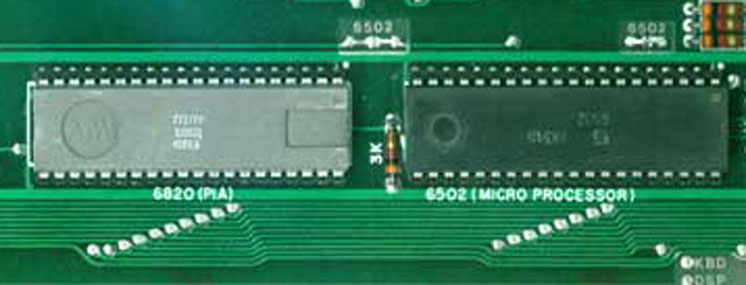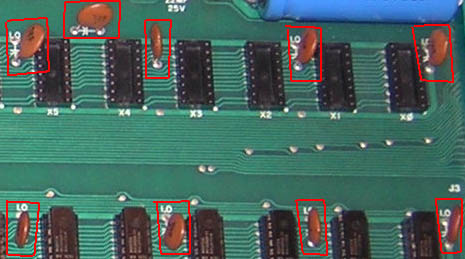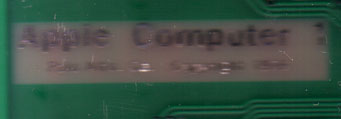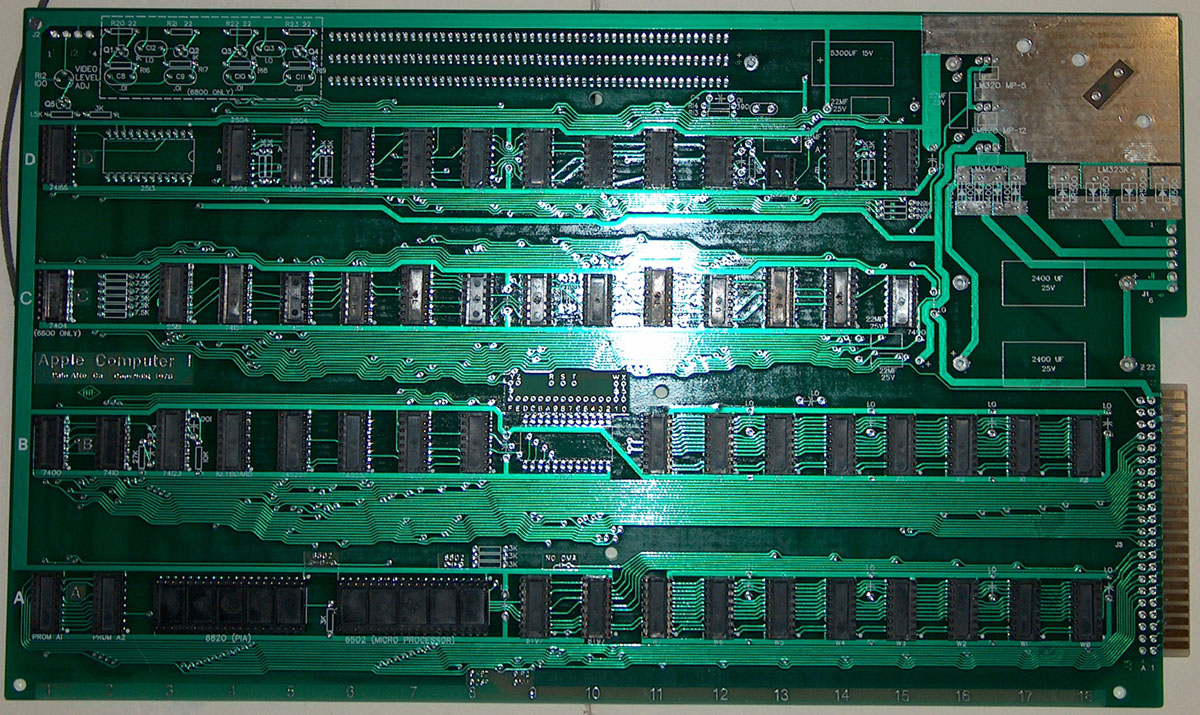|
As explained in the Apple-1 page there have been only 250 mainboards made
from the Apple-1 and that amount had been split in two runs,
of
which the first run consisted of 100 pieces ( later called the
"preNTI-version ) and the second run - which had been made
by the NTI-company and
that models from the second run have been called later the "NTI-version"
of the Apple 1.
Allthough the layout of the leads and traces havenīt been changed in that
second run, the assembly and the used components did
slightly differ
from the earlier "preNTI-version". In main the decoupling capacitors on
the second run have been more modern multilayer capacitors,
while in the
first run "old-fashioned" ceramic disccapacitors have been used. Another
change in assembly had been, that the majority of the
pre-NTI boards
still had been populated with the white ceramic version of the 6502 CPU
and the violett ceramic version of the 6820 PIA while in the
later NTI-version
nearly only the CPU and PIA with the plastic-case had been used. And in
the later NTI-version there have been different kinds of
small electrolytic
capacitors used ( ones in yellow cases instead of the blue cased ones
that have been only used in the "pre-NTI version".
But the very first remarkable difference to common users had been the
fact that NTI set itīs factory logo below the label from
Apple Computer
- a diamond square with the letters NTI inside of it.
Differences between "pre-NTI" version Newton
1 and the "NTI"-version of the Newton NTI board if populated
like original Apple-1
| |
"pre-NTI"
version Newton 1 |
|
"NTI"-version of the
Newton NTI |
| |
ceramic CPU and
PIA |
|
plastic CPU and PIA |
| |
 |
|
 |
| |
ceramic disc
decoupling capacitors |
|
multilayer ceramic decoupling
capacitors |
| |
 |
|
 |
| |
blue electrolytic
capacitors |
|
yellow electrolytic capacitors |
| |
 |
|
 |
a remark to the pictures
above: the different shades of green silkscreen on the boards is
partially also caused by dirt or bleaching of the sun !
But the very first remarkable difference to common users had been the
fact that NTI set itīs factory logo below the label from Apple
Computer
- a diamond square with the letters NTI inside of it.
| |
 |
|
 |
| |
here the Newton-1
board without the NTI-logo |
|
and here the Newton NTI board
with the NTI-logo |
The Newton1 is ( similar to the
MIMEO ) an replication of the "pre-NTI version" of the Apple-1
out from the first run. The reproduction of the mainboard
was carried out by Michael Ng, who also runs a computer museum. In fact
it seems to ms that the manufacturing of the Newton1 was a
reaction to the
fact that after Mike Willegal had made his īfirst limited edition of the
MIMEO ( which was also a reproduction of the pre-NTI version of
the Apple-1 ) and t
hat boards had been sold out after very short period of time and then for
a long period the community of Apple freaks had been quite a
while waiting -
the Newton1 had been made to solve the still not completely satisfied
complaints on more replications of the Apple-1 mainboard.
The NewtonNTI is an replication of the "NTI version"
of the Apple-1 out from the second run. The reproduction of
the mainboard was
carried out by Michael Ng, who also runs a computer museum. In fact it
seems to me that the manufacturing of the Newton NTI was a
reaction to the
fact that after Mike Willegal had made his īfirst limited edition of the
MIMEO ( which was also a reproduction of the pre-NTI version
of the Apple-1 ) and
that boards had been sold out after very short period of time and then
for a long period the community of Apple freaks had been
quite a while waiting -
bthe Newton 1 had een made to solve the still not completely satisfied
complaints on more replications of the Apple-1 mainboard.
But up till few months ago ( Oct 2012 ) all replications have been made
from the "per-NTI" version of the Apple-1 and not a single
replication was made
from the "NTI" version. So Michael Ng decided to make a run of
replications of this historical "second run" of the Apple-1.
Another reason was surely also that Michael Ng was experimenting / trying
to get a board "finish" with a coating getting closer to the
original by color
and surface. The Finish of the Newton-NTI is a very close copy to the
original NTI-version of the Apple-1. This sounds simple, but
it isnīt, because itīs
today very difficult to get asolderingmask with same color as used in the
mid seventies.... ao in very tiny specific details the
Newton1 is closer similar
to the originalApple-1 . But in the meantime amount of availiable boards
of the Newton-NTi is very limited - itīs nowadays difficult
to get "hands-on"
one of those boards.
Maybe some day in the future Michael Ng will raise another limited run of
that boards.
Just to tell this clear: All series of replication boards from the
Apple-1 have been made only in restricted and limited amount
of pieces ( some runs had
50 pieces like those from Michael Ng and others like the MIMEO ( now the
second run availiable ) from Mike Willegal have runs with
about only 100
units. So even replications are still quite rare and there are quite some
order waiting lists for future runs. And among the
replications there is a wide
spread of authenticity. Specially if the user wants to populate the board
with as similar as possible parts the "true" facsimiles are
rather rare. In the
meantime itīs nearly impossible to get the TI-sockets used on the
original boards and a lot of other obsolete parts are also
very difficult to get.
Anyhow i allready had ordered a MIMEO board in September 2012, when few
weeks later Michel Ng posted at applefritter the release of
a run of
Newton NTIboards and i immediatly put myself on the waitinglist for that
board. After several weeks he announced the first shippings
of this board to
be processed and iwaited for the board to arrive in December 2012. In the
meantime i started with the assembly of the MIMEO and
collected
information on the NTI-version.
I discovered that many more original boards from the "preNTI" version did
exist compared to the larger amount of the NTI-version
released later. It
took quite a lot time to collect the availiable pictures of the remaining
original NTI-boards and analyzing the boards for the
populated parts on it to find
the differences between both versions. The main differences i now listed
above. Comparing the amount of availiable replica boards i
would guess the
NTI-replication to be quite rare among those replications. The amount of
MIMEOīs, Obtronix, and Newton-1 all together might sum up to
about 400 to
500 Boards all together ( not counting in this list the amount of
replica-1 boards - because i donīt claim them to be true
replications - but rather more
only being a modern "emulation-board" with modern chips and no real
comparability with the original Apple-1 ) and only about 50
NTI-version like
replications by the Newtoin NTI.
So among the total amount of replication boards the Newton NTI is a quite
rare ( because only replication of the NTI-version )
reproduction of the
Apple-1.
Due to the fact that i also received in December an invitation to
take part at the Vintage Computer Festival Europe in end of
April 2013 i decided to
make a transparent case for the Newton NTI and take it along to the
VCFe together with the MIMEO and set both together besides
each other and
permit the visitors to compare both versions with each other. Also
the case for the Newton NTI was designed to bear the new
designed
slotexpansionboard in the case too.
| |
 |
The picture above shows the
board with the sockets soldered and
the picture below shows the board mounted on the groundplate with the
slotexpansion-board.
The
following picture displays the state of the board in end of
February 2013 and still a lot of components missing ( shaded
grey ):
The next picture
displays the status of the Board 4 weeks before itīs exhibition
at the VCFs in end of April 2013:
At this point
i was still hunting for a keyboard that i could use with this
board. I finally decided to use an early Apple II keyboard and
mofify it for use
with this NTI-Board. I then added in this case as well
as also in the MIMEO case an adapter from Mike Willegal, that
permits use of a PS2 keyboard
together with the board. That should permit to protect
the old keyboard and instead use in "normal mode" a modern
keyboard.
The picture above
shows the state of the case short before the VCFe started.
In fact it turned out, while making examinations with the
expansioncards, that the boards donīt differ by the layout, but
they surely result in
differences by their population. In fact the use of different
decoupling capacitors and different electrolytic capacitors seem
to have quite remarkable
effect to the clocking signals and the bussignals. In the
NTI-version the signals are much less disturbed by "noise" ( or
say: spikes and unwanted
flattening of signals ) resulting from the rather simple
powersupply stabilization. For demonstretion purpose i have
taken some pictures from the
oscilloscope and set them in the > table below besides
eachother - and you can compare them by yourself:
|